If you are a claustrophobic person, then neither a bivy tent nor a bivy bag are for you. But indeed there are differences between these two shelters worth considering, and they are discussed in detail here.
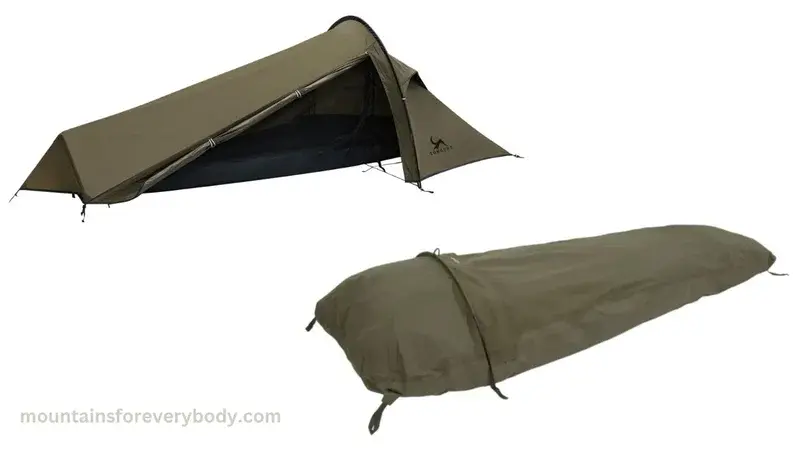
When it comes to lightweight shelters for outdoor adventures, “bivy tent” and “bivy bag” are terms that often spark debate among hikers, campers, and climbers.
Both are tailored for solo travelers who value portability, but they differ in design, functionality, and comfort. Knowing what sets them apart can guide you to the right choice.
What is a bivy bag?
A bivy bag or bivouac sack is a waterproof, preferably breathable shell that slips over your sleeping bag. Originally developed for mountaineers needing a compact shelter for unexpected nights out (or “bivouacs”) on rugged terrain, it’s the epitome of minimalist gear.
The best among them are made from materials like Gore-Tex or similar fabrics. Bivy bags shield you from rain, wind, and snow while letting body moisture escape.
Typically weighing between 0.5 to 2 pounds (0.2 to 0.9 kg), some bivy bags packs down to the size of a small water bottle. It hugs your sleeping bag tightly, with an opening or hood near your face.
One great example is in the picture, the AquaQuest Pharaoh Bivy Sack. The official waterproof rating here is 10000 mm, and moisture vapor transmission rating of 10000 gr/m²/day.
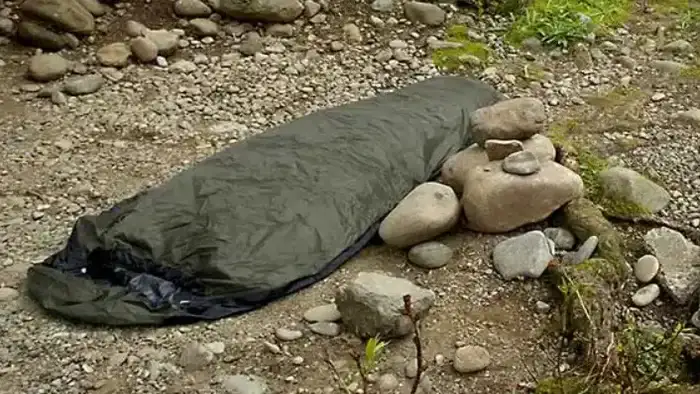
What is a bivy tent?
A bivy tent blends features of a bivy bag with those of a traditional tent, offering more structure and space while staying lightweight.
Designed for one person, it often uses two poles to create a small, elevated shelter above your sleeping bag, providing a limited headroom and a less restrictive feel. Some like the GEERTOP Ultralight Single Person Bivy Tent have three poles:

Unlike a bivy bag, a bivy tent is in most cases a full two-layer shelter with an inner tent that includes a defined floor and a mesh canopy, and a separate fly that sometimes includes a small vestibule for gear storage. One example is shown below, the Eureka Solitaire AL 1 person tent without and with the fly.
Typically weighing between 1.5 to 3 pounds (0.7 to 1.4 kg), a bivy tent is always heavier than a bivy bag due to its poles and extra fabric, but it’s still far lighter than a standard tent.
However, it is fair to say that there are ultralight standard backpacking tents that are much lighter, but they are also far more expensive.
The materials of bivy bags and bivy tents are similar, with waterproof floors, and breathable weather-resistant walls or canopy, but the added pole structure in a bivy tent enhances comfort and airflow.
Something in between: Hybrid bivy tent – bivy bag
So yes, there are models where it is hard to be sure and decide what they are, and this is where the confusion starts.
Some advanced models (of bivy bags) include a single pole or hoop at the head to lift the fabric away from your face, improving ventilation and reducing that cocooned feeling.
With this, the differences between a bivy tent and a bivy bag are reduced, and it is hard to say which is which. One example is the AquaQuest Hideaway Bivy Stealth Compact Single-Pole Hooped Tent, observe the word Tent in the name:

Here is one more below, the Outdoor Research Helium Bivy Tent. As you realize, they call it a bivy tent, but I would say if this is a tent then this is an extreme type. Both of them are bivy bags for me.
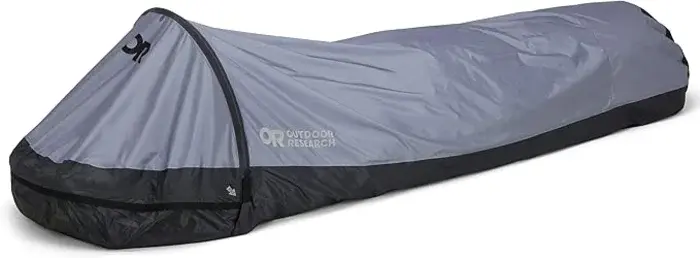
But there is more, see this Snugpak Stratosphere Shelter 1 Person in the picture below. It has two loops in the head area, and this makes it freestanding, but there is no loop in the feet area. Now, is it a bivy tent or a bivy bag? I cannot call this a tent, how about you?

Key differences between bivy tents and bivy bags
Though both are lightweight solo shelters, their differences lie in construction, comfort, and use cases. Here’s how they compare:
Size and space
Bivy bag: Tight and compact, with minimal room beyond your sleeping bag. Models with a head pole offer slight relief but still prioritize a small footprint.
Bivy tent: Larger, with a structured frame (one, two, or even three poles) that creates headroom and sometimes space for gear.
Weight and packability
Bivy bag: Ultra-light and highly packable, ideal for those cutting every ounce. You have seen the AquaQuest Pharaoh Bivy Sack above, it weighs only 1.1 lb (0.5 kg).
Bivy tent: A bit heavier and bulkier due to poles and two-layer design, though still compact compared to most of standard one-person tents.
Protection
Bivy bag: Reliable against wind and rain, but condensation can build up inside, especially without a head pole.
However, observe that some of them do not protect your face. In rain, they can work only if a small tarp is added. In the simplest models, you do not have protection from insects. The Snugpak Special Forces Bivvi Bag in the picture shows this detail.
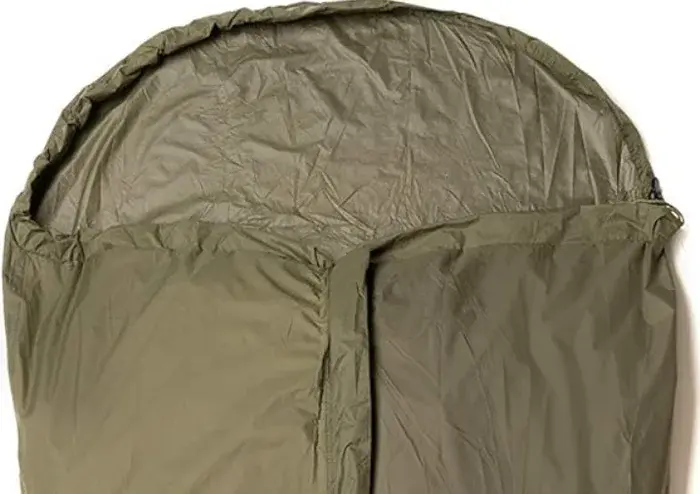
It is completely different with bivy bag models that have a loop added above the face. You have seen one example in the top picture above, the Carinthia XP Two Plus bivy bag. Here is a closer look:

Here you can have a mesh as a second layer to use when the sky is clear while being protected from insects. When it rains, you have a flap. This is typical also for Outdoor Research models, but they call them tents, contrary to Carinthia brand that uses the word bag.
Bivy tent: Better ventilation from its raised design, mesh canopy, and fly that normally always has vents, reducing dampness while keeping weather out. Full insects protection is always there.
The ALPS Mountaineering Stealth 1-Person Bivy Tent below has vents on both sides, and this is far superior to any bivy bag. Note also that it weighs only 2 lb (0.91 kg), and it is lighter than the Carinthia bivy bag above that weighs 2.6 lb (1.185 kg).

Comfort and livability
Bivy bag: Minimalist and potentially claustrophobic; even with a head pole, movement is limited.
Bivy tent: A touch more livable. My Ferrino Lightent 1 tent’s two-pole setup gives me space to shift around, but sitting upright is a fantasy.

Setup
Bivy bag: Almost instant, slide it over your sleeping bag, or set up a single head pole if included.
Bivy tent: Quick but requires staking and pole insertion. Then you attach the fly, and stake out vents. So, this implies dealing with stakes, and the ground may not always allow this to do.
When to choose a bivy bag
A bivy bag shines when weight and simplicity are paramount. It’s best for:
- Climbers needing an emergency shelter on multi-day ascents.
- Ultralight backpackers obsessed with minimizing pack weight.
- Short trips where basic protection trumps comfort.
Models with a head pole improve breathability, but they’re still less suited for prolonged wet or humid conditions due to inevitable condensation.
When to choose a bivy tent
A bivy tent offers a middle ground between portability and livability, making it ideal for:
- Solo adventurers wanting more space and comfort than a bivy bag allows.
- Multi-day trips where ventilation and gear storage matter.
- Mixed weather, where a pole (or two) keeps the shelter airy and functional.
My two-pole Ferrino bivy tent, for instance, provides a lightweight yet structured option, balancing ease of use with added comfort.
Conclusion
Choosing between a bivy tent and a bivy bag hinges on your needs. A bivy bag, whether with a head pole or not, is unbeatable for ultralight travel and emergency use, keeping you protected with minimal fuss.
A bivy tent, with one pole or the more common two-pole design, delivers extra space and comfort for a small weight penalty, perfect for longer or more leisurely trips.
Both embody the minimalist ethos, ensuring you’re ready for adventure without weighing you down. But read a bit more about bivy tents in my another text.
Thank you for reading. Let me know if you have questions or comments, there is a comment box below. Subscribe to my weakly newsletter and stay informed, the subscription form is given below.

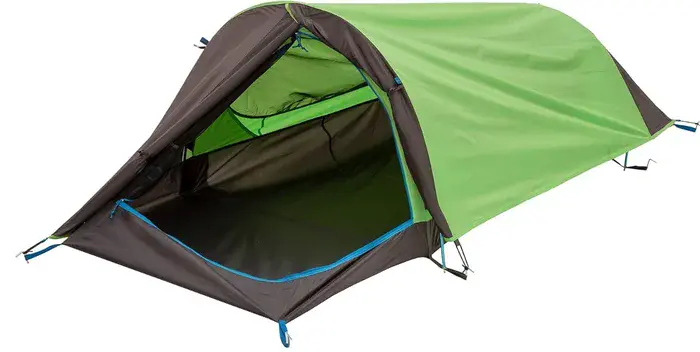
Leave a Reply